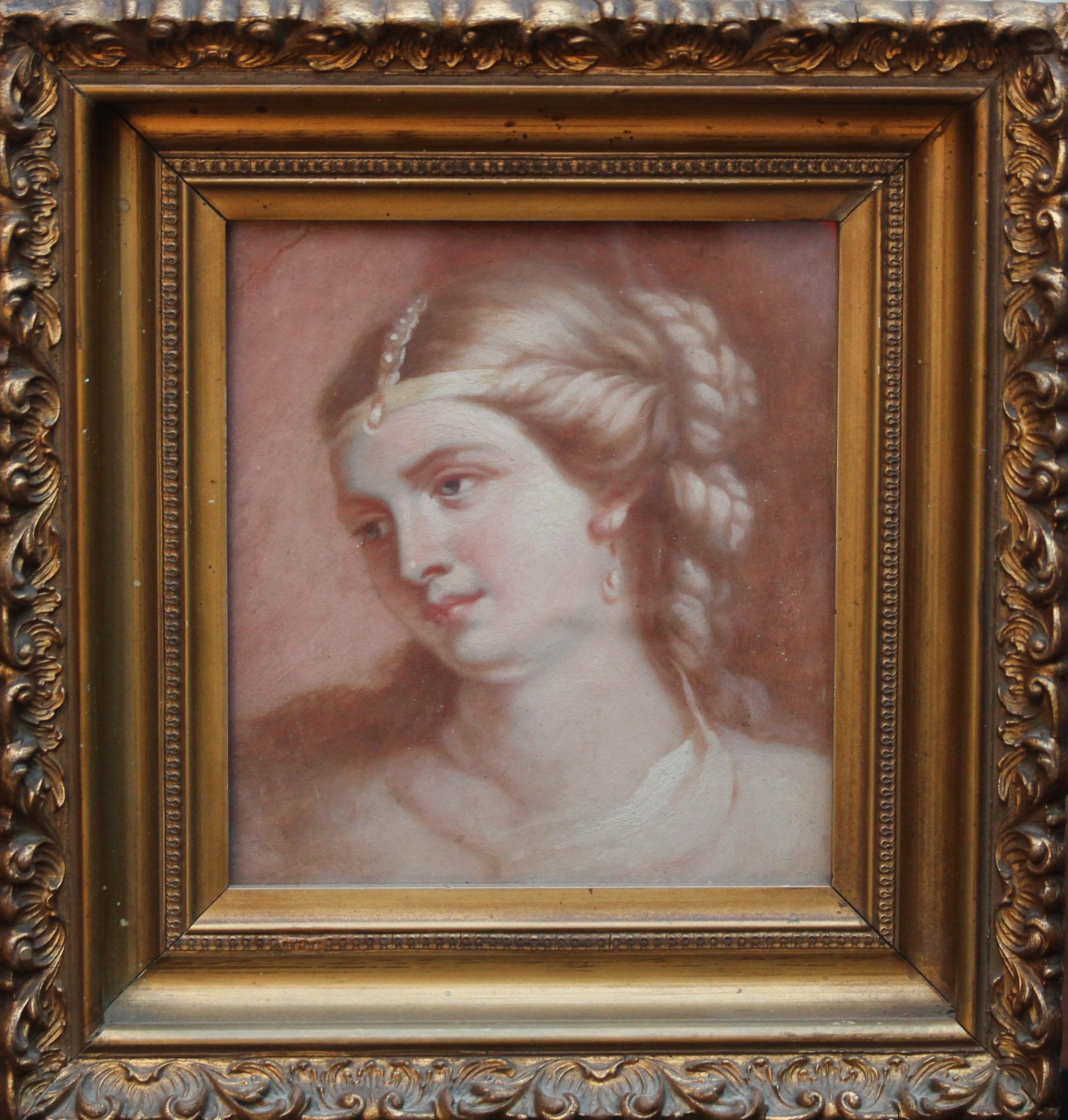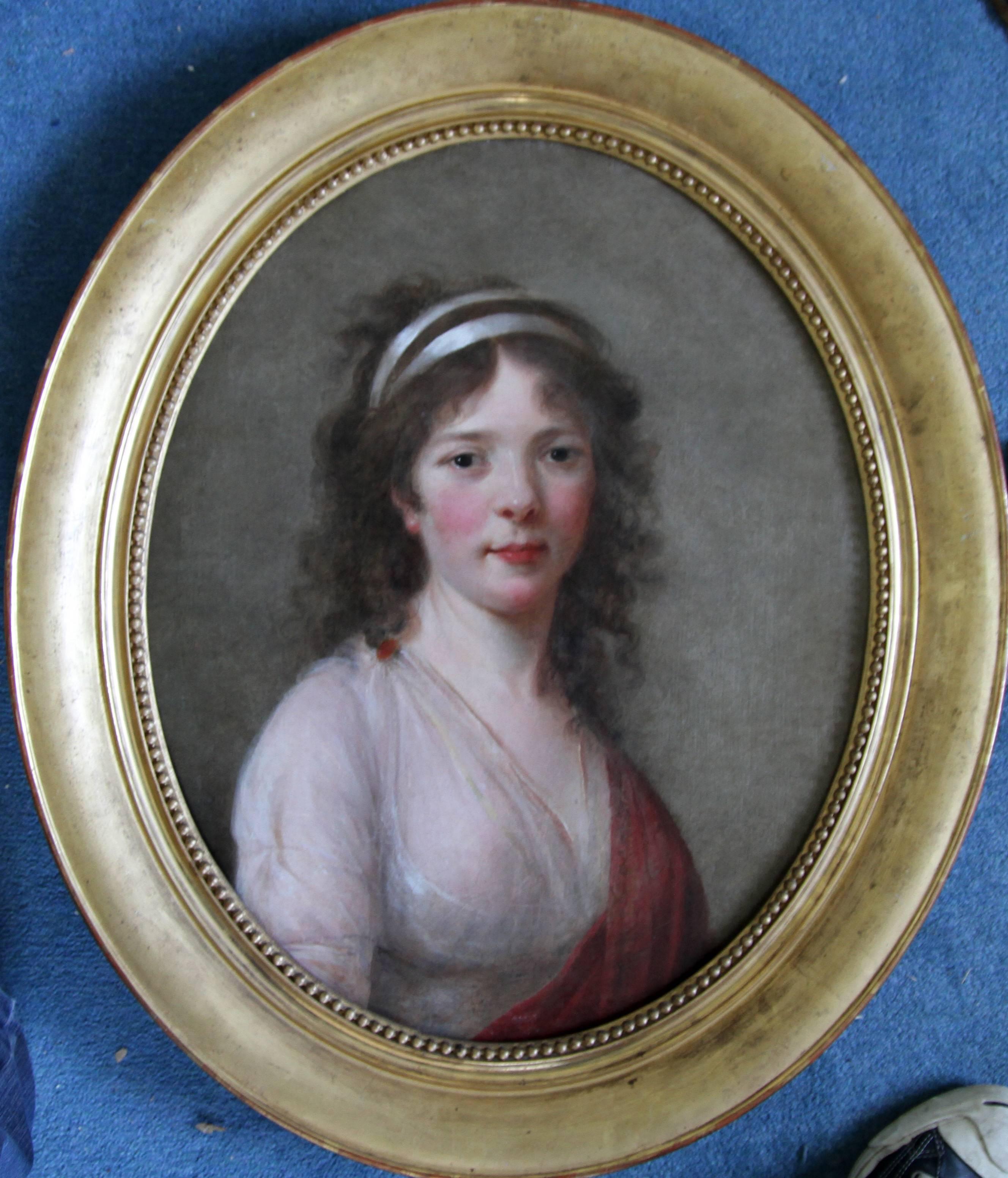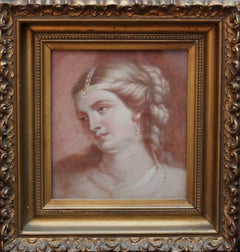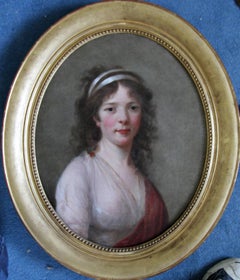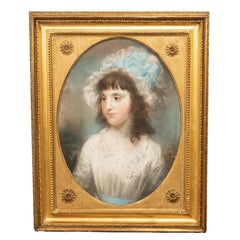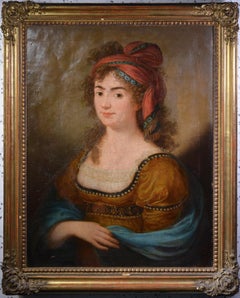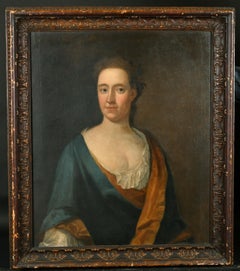Items Similar to Portrait of Lady in Mob Cap - British Old Master 18th century art oil painting
Want more images or videos?
Request additional images or videos from the seller
1 of 14
John Russell (att)Portrait of Lady in Mob Cap - British Old Master 18th century art oil paintingCirca 1790
Circa 1790
$4,082.62
£2,975
€3,497.98
CA$5,636.98
A$6,251
CHF 3,284.43
MX$76,376.54
NOK 41,092.75
SEK 38,572.57
DKK 26,113.07
About the Item
This charming British Old Master Regency pastel portrait is attributed to John Russell RA. Painted circa 1790 the composition is a blonde woman in pretty mob cap with a blue ribbon. A really lovely image.
Provenance. Oxford estate.
Condition. Oil pastel on paper, 23 inches by 19 inches unframed and in good condition but has line in paper in middle.
Frame. Housed in a fine frame, 30 inches by 26 inches framed and in good condition.
John Russell RA (1745-1806) was an English painter renowned for his portrait work in oils and pastels, and as a writer and teacher of painting techniques. Russell was born in Guildford, Surrey, the son of John Russell Snr., book and print seller and five times mayor of the town; his father was something of an artist, and drew and published two views of Guildford. Russell was educated at the Royal Grammar School, Guildford, and soon showed a strong inclination for art. He trained under Francis Cotes RA (of Cavendish Square, London), one of the pioneers of English pastel painting, and, like Cotes, was an admirer of the pastel drawings of Rosalba Carriera whose methods influenced his technique of "sweetening". At the age of 19 he converted to Methodism, which was the cause of tension with his family and with his teacher; he made no secret of his strong evangelical leanings and would attempt to preach and convert at every opportunity. Russell set up his own studio, in London, in 1767. He made the acquaintance of the notorious Dr. William Dodd, whose portrait he painted in 1768. He was introduced to Selina, Countess of Huntingdon, who unsuccessfully attempted to persuade him to give up painting and attend her Methodist ministers' training college at Trevecca in Wales. On 5 February 1770, he married Hannah Faden, daughter of a Charing Cross print and map seller, whom he had converted. They lived at No. 7 Mortimer Street, Cavendish Square, where he had moved in 1770. Russell's work caused him to travel extensively around Britain. In 1772, he wrote Elements of Painting with Crayons, by which time he had won premiums for his drawings from the Society of Arts in 1759 and 1760, and entered the Royal Academy school of art in 1770, winning its gold medal for figure drawing the same year. He exhibited at the Society of Artists of Great Britain in 1768 and showed 330 works at the Academy between 1769 until and his death. In 1770, Russell painted Methodist minister, George Whitefield (engraved by James Watson) and the future philanthropist, William Wilberforce, then only eleven years old. In 1771, he exhibited a portrait in oils of Charles Wesley at the Royal Academy and, in 1772, painted Selina, Countess of Huntingdon in pastel. This was a symbolic picture, and was lost on its voyage out; but it was engraved, and he later also painted her in oils. Also in that year he was elected an associate of the Royal Academy. The following year, 1773, he painted John Wesley (engraved by Bland). In 1788, after a long wait, Russell was elected a royal academician, in the same year painting a portrait of the naturalist Sir Joseph Banks. In 1789, he was commissioned to portray the royal physician Francis Willis. The results obviously pleased the monarch as, in 1790, he was appointed Crayon (pastel) Painter to King George III, Queen Charlotte, the Prince of Wales (both of whom Russell also painted) and the Duke of York. With such royal patronage, he developed a large and fashionable clientele. Russell was a man of deep religious beliefs, a devout follower of George Whitefield. He began an elaborate introspective diary in John Byrom's shorthand in 1766 and continued it to the time of his death. In it, he recorded his own mental condition and religious exercises, and occasionally information concerning his sitters. Though his religion appears to have become less militant after his marriage, his diary bears witness to his anxiety with regard to his spiritual welfare. Not only would he not work on Sunday, but he would allow no one to enter his painting-room. He was afraid to go out to dinner on account of the loose and blasphemous conversation which he might hear. He was on good terms with Sir Joshua Reynolds, with whom he dined at the academy, the Dilettanti Society, and the Literary Club (now The Club), but he records that on these or other festive occasions he always left early. He was troubled by ill-health for much of his life, and in 1803 became almost deaf following a bout of cholera. He died in Hull in 1806 after contracting typhus. Russell's work can be viewed at many galleries in the UK and around the world, but the largest collection is held by Guildford House Art Gallery in Guildford. Many of his portraits were engraved by, amongst others, Joseph Collyer, Charles Turner, James Heath, Dean, Bartolozzi and Trotter. Russell was interested in astronomy and made, with the assistance of his daughter, a lunar map, which he engraved on two plates which formed a globe showing the visible surface of the Moon – it took twenty years to finish. He also invented an apparatus for exhibiting the phenomena of the Moon, which he called "Selenographia". Russell's large and highly detailed pastel drawing of The Face of the Moon (1793–1797) is "the most faithful early representation of the lunar sphere". Some of his best portraits were of the era's acclaimed scientists, such as his friend William Herschel, who he depicted holding a stellar chart showing his discovery of Uranus. It was Herschel who provided the powerful telescope that Russell used for his painstaking lunar observations. Of his twelve children (of which four died in infancy), William Russell (1780–1870), exhibited portraits at the Royal Academy from 1805 to 1809. The National Portrait Gallery contains a portrait of Judge Sir John Bailey by him. Two of John's daughters, Anne and Jane became artists as well.
- Creator:John Russell (att) (1745 - 1806)
- Creation Year:Circa 1790
- Dimensions:Height: 30 in (76.2 cm)Width: 26 in (66.04 cm)Depth: 2 in (5.08 cm)
- Medium:
- Movement & Style:
- Period:
- Condition:
- Gallery Location:Hagley, GB
- Reference Number:1stDibs: LU853113342212
About the Seller
5.0
Platinum Seller
Premium sellers with a 4.7+ rating and 24-hour response times
1stDibs seller since 2018
463 sales on 1stDibs
Typical response time: <1 hour
- ShippingRetrieving quote...Shipping from: Hagley, United Kingdom
- Return Policy
Authenticity Guarantee
In the unlikely event there’s an issue with an item’s authenticity, contact us within 1 year for a full refund. DetailsMoney-Back Guarantee
If your item is not as described, is damaged in transit, or does not arrive, contact us within 7 days for a full refund. Details24-Hour Cancellation
You have a 24-hour grace period in which to reconsider your purchase, with no questions asked.Vetted Professional Sellers
Our world-class sellers must adhere to strict standards for service and quality, maintaining the integrity of our listings.Price-Match Guarantee
If you find that a seller listed the same item for a lower price elsewhere, we’ll match it.Trusted Global Delivery
Our best-in-class carrier network provides specialized shipping options worldwide, including custom delivery.More From This Seller
View AllPortrait of Mrs Harborough - British 18th century art portrait lady oil painting
Located in Hagley, England
This lovely 18th century Old Master portrait oil painting is attributed to the circle of noted portrait artist Enoch Seeman. Seeman came from Poland to England as a youngster with hi...
Category
18th Century Old Masters Portrait Paintings
Materials
Oil
Portrait of a Lady - Old Master Scottish art oil painting by RSA president
By John Gordon Watson
Located in Hagley, England
A fine Old Master British portrait oil painting which dates to circa 1830 and depicts a girl. Painted by the president of the Royal Scottish Academy, Sir John Watson Gordon...
Category
19th Century Old Masters Portrait Paintings
Materials
Oil
Portrait of Mrs James Hoste - British 18th century art portrait oil painting
By John Vanderbank
Located in Hagley, England
This superb large three quarter length British Old Master portrait in a landscape oil painting is attributed to circle of John Vanderbank the Younger. Painted circa 1738 the sitter is Mrs James Hoste of South Wootton and Sandringham, nee Hammond. She was the daughter of Anthony Hamond and Susan Walpole, daughter of Robert Walpole, and was sister to Robert, 1st Earl of Oxford. She married Major James Hoste of Sandringham, Norfolk, and they had two daughters. The sheen of her blue satin dress against her gold cloak is stunning. A really lovely 18th century portrait with excellent provenance.
Inscribed with sitter details lower left.
Provenance. By descent within the family of the sitter at West Acre High House, Norfolk;
Cheffins, Cambridge, 'West Acre High House' sale, 24 November 2010, Lot 519; Wood Hall, Arkesden, Essex.
Literature: 'Portraits in Norfolk Houses', Prince Duleep Singh, 1927, No. 36.
Sitter's details on two labels verso.
Condition. Oil on canvas, image size is 50 inches by 40 inches and in good condition.
Frame. Housed in an ornate gilt frame, 58 inches by 48 inches framed and in good condition.
John Vanderbank (1694-1739) was an English portraitist and book illustrator, who enjoyed a high reputation for a short while during the reign of King George...
Category
18th Century Old Masters Portrait Paintings
Materials
Oil
Portrait of Madam van Robais - French Old Master oil painting 18th century art
Located in Hagley, England
This fine French Old Master portrait oil painting on canvas dates to circa 1770 and is attributed to the circle of Elizabeth Vigee Le Brun. The sitter is Madam van Robais.
The van R...
Category
18th Century Old Masters Portrait Paintings
Materials
Oil
Portrait of a Lady with a Blue Bow - British 18thC art Old Master oil painting
Located in Hagley, England
This superb British 18th century Old Master portrait oil painting is attributed to Matthew William Peters. Painted circa 1780 it is a fine half length portrait of a woman gazing to her left. She has a lovely blue bow and sash on her dress. The sympathetic detail in her face is sublime. A really wonderful 18th century Old Master portrait. Matthew William Peters was known for his late 18th century portraits which had both the influence of Sir Joshua Reynolds and Thomas Gainsborough.
Provenance. Lincolnshire estate.
Condition. Oil on canvas 30 inches by 25 inches unframed and in good condition. Has has restoration.
Frame. Housed in an ornate gilt carved swept period frame, 40 inches by 35 inches framed and in good condition.
Matthew William Peters (1742-1814) was an English portrait and genre painter who later became an Anglican clergyman and chaplain to George IV. He became known as "William" when he started signing his works as "W. Peters". Peters was born in Freshwater, Isle of Wight, the son of Matthew Peters (born at Belfast, 1711), a civil engineer and member of the Royal Dublin Society; by Elizabeth, the eldest daughter of George Younge of Dublin. The family moved from England to Dublin when Peters was young. Peters received his artistic training from Robert West in Dublin; in 1756 and 1758 he received prizes from the first School of Design in Dublin. In 1759, he was sent by the Dublin Society to London to become a student of Thomas Hudson and won a premium from the Society of Arts. The group also paid for him to travel to Italy to study art from 1761 to 1765. On 23 September 1762 he was elected to the Accademia del Disegno in Florence. Peters returned to England in 1765 and exhibited works at the Society of Artists from 1766 to 1769. Beginning in 1769, Peters exhibited works at the Royal Academy. In 1771 he was elected an associate and in 1777 an academician. He returned to Italy in 1771 and stayed until 1775. He also probably traveled to Paris in 1783–84, where he met Léopold Boilly, Antoine Vestier, and was influenced by the work of Jean-Baptiste Greuze. On 27 February 1769, Peters became a freemason, and he was made the grand portrait painter of the Freemasons and the first provincial grand master of Lincolnshire in 1792. In 1785, he exhibited portraits of the Duke of Manchester and Lord Petre as Grand Master at the Royal Academy exhibition. According to Robin Simon's article in the Oxford Dictionary of National Biography, no British contemporary had such an Italian manner of painting as Peters, reflecting the old masters he copied. Many of Peters' works were erotic and although these works did not damage his career, according to Simon, Peters later regretted these when he became an ordained clergyman in 1781. He served as the Royal Academy's chaplain from 1784 to 1788, at which time he resigned to become chaplain to the Prince of Wales. In 1784, Peters was awarded the living of Scalford, Leicestershire by Charles Manners, 4th Duke of Rutland. In 1788, the Dowager Duchess gave him the living at Knipton, at which time he also obtained that at Woolsthorpe. These livings were near to Belvoir Castle...
Category
18th Century Old Masters Portrait Paintings
Materials
Oil
Portrait of a Lady - Old Master British early 19thC oil painting woman bonnet
By Thomas Lawrence (circle)
Located in Hagley, England
A fantastic British oil painting which is unsigned and is circle of Thomas Lawrence. It depicts a portrait of a lady and dates to circa 1820. This is a super portrait painting which ...
Category
19th Century Old Masters Portrait Paintings
Materials
Oil
You May Also Like
Important 18th Century Pastel Portrait Painting Young Girl John Russell RA 1789
By John Russell
Located in Portland, OR
An important authenticated & documented 18th century portrait by John Russell R A (1745-1809), England, signed & dated 1789.
This rather charming & sensitive portrait of a young girl...
Category
1780s English School Portrait Paintings
Materials
Oil Pastel
Portrait Noble Woman Ranc Paint Oil on canvas 17/18th Century Old master France
Located in Riva del Garda, IT
Portrait of a noblewoman in ceremonial dress with Chantilly lace mantilla
Attributed to Jean Ranc (Montpellier 1674 - 1735 Madrid)
oil on oval canvas
cm.72 ...
Category
18th Century Old Masters Paintings
Materials
Oil
$5,447 Sale Price
20% Off
Antique 18th Century Neoclassical Oil Portrait Young Lady Turban Unknown Master
Located in Stockholm, SE
This captivating oil portrait from the late 18th to early 19th century depicts a mysterious charming young woman, painted by an unknown but clearly professional master, presumably Fr...
Category
Late 18th Century Realist Portrait Paintings
Materials
Gold Leaf
Fine 18th Century British Portrait of an Aristocratic Lady, Large oil painting
Located in Cirencester, Gloucestershire
Circle of Thomas Hudson (1701-1779) British.
18th Century Bust Portrait of a Lady,
Oil on Canvas, Inscribed on a label verso,
canvas: 30" x 25" (76.2 x 63.5cm).
frame: 30 x 25 in...
Category
Mid-18th Century Old Masters Portrait Paintings
Materials
Canvas, Oil
Large 18th Century English Old Master Oil Painting Portrait of Lady on canvas
Located in Cirencester, Gloucestershire
Portrait of a Lady
English School, 18th century
oil on canvas, unframed
canvas : 31 x 25 inches
provenance: private collection, UK
condition: good and sound condition
Category
Early 18th Century Old Masters Landscape Paintings
Materials
Oil, Canvas
Unknown: Portrait of a Scottish Lady Oil on Canvas
Located in Montreal, QC
This historical portrait of a Lady, was chosen for exhibition at the "Palace of History" in the Scottish Exhibition in Glasgow in 1911.
She is fashionably dressed in evening clothes...
Category
Antique Mid-19th Century Scottish Victorian Paintings
Materials
Paint
More Ways To Browse
Prints Of 18th Century Paintings
Oil Painting Dining Room
Paintings 18th Century Religious Paintings
Old Map Frames
Framed 18th Century British Prints
18th Century Oil Painting Woman
Antique Telescopes
Lady Dior Gray
King William Iii
Map Of Oxford
Moon Man Gold
18th Century George Iii Painting
Globe Trotter
Queen Charlotte
Antique Apparatus
18th Century British Paintings
James Reynolds
English Regency Portrait

